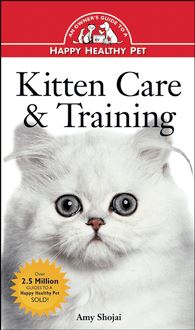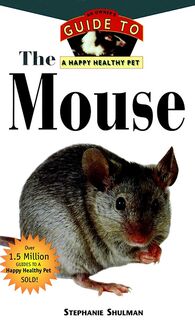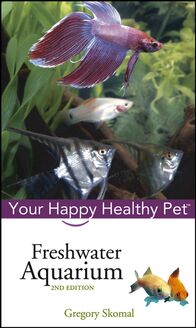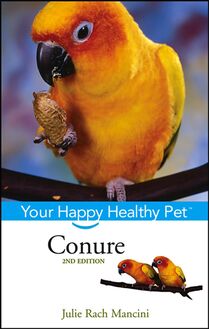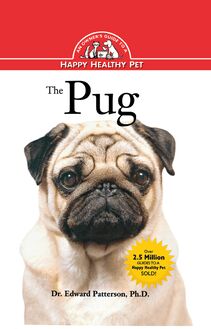The Mouse , livre ebook
75
pages
English
Ebooks
2007
Vous pourrez modifier la taille du texte de cet ouvrage
Obtenez un accès à la bibliothèque pour le consulter en ligne En savoir plus
Découvre YouScribe en t'inscrivant gratuitement
Découvre YouScribe en t'inscrivant gratuitement
75
pages
English
Ebooks
2007
Vous pourrez modifier la taille du texte de cet ouvrage
Obtenez un accès à la bibliothèque pour le consulter en ligne En savoir plus
Publié par
Date de parution
27 août 2007
Nombre de lectures
1
EAN13
9780470253083
Langue
English
Poids de l'ouvrage
1 Mo
PART ONE: Welcome to the World of the Mouse.
1. The History of the Mouse.
2. Mice as Pets.
3. Understanding Your Mouse.
PART TWO: Caring for Your Mouse.
4. Selecting Your Mouse.
5. Housing Your Mouse.
6. Feeding Your Mouse.
7. Vacations and Your Mouse.
8. Keeping Your Mouse Healthy.
PART THREE: Fun with Fancy Mice.
9. Mouse Varieties.
10. Showing Your Mouse.
PART FOUR: Beyond the Basics.
11. Recommended Reading and Resources.
Publié par
Date de parution
27 août 2007
Nombre de lectures
1
EAN13
9780470253083
Langue
English
Poids de l'ouvrage
1 Mo
The
Mouse
Howell Book House
IDG Books Worldwide, Inc.
An International Data Group Company
Foster City, CA Chicago, IL Indianapolis, IN New York, NY Southlake, TX
Howell Book House
IDG Books Worldwide, Inc.
An International Data Group Company
919 E. Hillsdale Boulevard
Suite 400
Foster City, CA 94404
Copyright 2000 by Howell Book House , a wholly owned subsidiary of IDG Books Worldwide, Inc.
Copyright 2000 photography by Eric Ilasenko unless otherwise noted
All rights reserved. No part of this book may be reproduced or transmitted in any form or by any means, electronic or mechanical, including photocopying, recording, or by an information storage and retrieval system, without permission in writing from the Publisher.
Howell Book House is a registered trademark of Macmillan General Reference USA, Inc., a wholly owned subsidiary of IDG Books Worldwide, Inc.
The IDG Books Worldwide logo is a registered trademark under exclusive license to IDG Books Worldwide, Inc., from International Data Group, Inc.
For general information on IDG Books Worldwide s books in the U.S., please call our Consumer Customer Service department at 800-762-2974. For reseller information, including discounts and premium sales, please call our Reseller Customer Service department at 800-434-3422.
Library of Congress Cataloging-in-Publication Data
Shulman, Stephanie.
The mouse : an owner s guide to a happy healthy pet / [Stephanie Shulman].
p. cm.
Includes bibliographical references.
ISBN 1-58245-006-4
1. Mice as pets. I. Title
SF459.M5S54 1999
636.9 353-dc21 99-37567
CIP
Manufactured in the United States of America
10 9 8 7 6 5 4 3 2 1
Series Director: Amanda Pisani
Book Design: Michele Laseau
Cover Design: Iris Jeromnimon
Illustration: Laura Robbins
Photography: All photographs by Eric Ilasenko unless otherwise noted.
Production Team: Christina Van Camp, David Faust, Toi Davis
Contents
part one Welcome to the World of the Mouse
1 The History of the Mouse
2 Mice as Pets
3 Understanding Your Mouse
part two Caring for Your Mouse
4 Selecting Your Mouse
5 Housing Your Mouse
6 Feeding Your Mouse
7 Vacations and Your Mouse
8 Keeping Your Mouse Healthy
part three Fun with Fancy Mice
9 Mouse Varieties
10 Showing Your Mouse
part four Beyond the Basics
11 Recommended Reading and Resources
part one
chapter 1
The History of the Mouse
How could anyone not love sweet and gentle mice? If you were to hold mice and study them for even a brief period of time, you would soon recognize their spectacular nature. Mice have perfectly engineered bodies and are able to move with the greatest agility. Their constant curiosity excites them into action. Their lovable faces peer at you inquisitively, and their tiny paws grasp firmly as they climb into your pockets, looking for a special treat.
Based on their friendly nature alone, mice are marvelous pets for people of almost any age. Through years of breeding, their skittish nature has been refined to reveal a tamer animal that enjoys human companionship.
Some people do not consider the mouse to be a proper pet. These people regard the mouse as a pest that destroys property and carries disease. Even though we now understand the joy that smaller creatures can bring to us, the mouse is still one of the most misunderstood of pets. Many people do not see the benefits of having such a small friend. But the mouse is an active and social creature.
MAN VERSUS MOUSE
Mice are believed to have evolved in Asia about 40 million years ago, during the Eocene epoch of the Tertiary Period of the Cenozoic Era, at least 3.8 million years before the appearance of modern man!
These pocket pets, as they are sometimes called, love to explore and interact with you. They are fastidious animals, constantly grooming themselves, washing their fur, cleaning behind the ears with their paws and tidying their tails. These curious creatures are always ready to investigate. Mice become tame and make great friends. Man s ongoing relationship with the mouse has benefited us in research and education as well as in friendship and fun.
If you are thinking of getting a mouse, you must ask yourself: Am I ready to become an active participant in my new pet s life? You must have the time to provide not only food, water and housing, but also quality friendship. Creating and maintaining a bond with this little creature provides you with hours of fun and valuable insight into the animal kingdom. In return, you become your pet s voice to the human world. You keep him safe and warm, providing him with playtime and- if necessary-medical attention. If you feel you have even thirty minutes a day to devote exclusively to this pet, you are ready for a mouse.
The Adaptable Mouse
Mice do well wherever they go. They are highly adaptable creatures and live well in varied conditions. They are omnivores, which means they eat both plants and animals. Indeed, mice are willing to make a meal of almost anything. Although the mouse feeds primarily on vegetables, roots, grains, seeds, and some insects for variety, he has made his home with man and has feasted on such delicacies as leather, soap, lard, paste, paper and wax.
Mice also have the ability to reproduce easily so that a population of mice is easily established. If their safety is threatened, mice will quickly settle in a new location. As the Roman dramatist Plautus observed in 190 B.C ., Consider the little mouse, how sagacious an animal it is which never entrusts its life to one hole. With danger always lurking, a mouse does not hesitate to build a nest in a new location.
Mice in the Animal World
Mice are rodents members of the order Rodentia . This word comes from the Latin word rodere , meaning to gnaw.
S OMETHING TO G NAW O N
Mice and other rodents are known for their gnawing. Rodents are characterized by having four chisel-shaped incisors, two in the upper jaw and two in the lower jaw. These sharp teeth grow continuously throughout the animal s life. Rodents also have twelve molars for grinding, three on each side of the upper jaw and three on each side of the lower jaw. This arrangement of teeth allows mice to chew away at almost any kind of material. Constant chewing keeps the teeth worn down. If the teeth grow too long, the mouse is unable to eat and will die. Thus, mice go right on chewing.
Mice have lived alongside man for centuries. Urban areas offer many opportunities for wild mice to get an easy meal .
E EEK ! A M OUSE (I T HINK . . .)
On occasion, people find it difficult to distinguish mice from rats. Rats are generally larger than mice, usually four times as large as the little mouse. Sometimes a mouse can grow to be as large as a small rat. Rats are considered the more intelligent of the two animals and are easier to handle than the more skittish mouse. However, some people find the mouse more appealing, for the rat has a longer, pointier face and a thicker tail. Two rats commonly associated with mice are the black rat ( Rattus rattus ), also called the ship or roof rat, and the Norway rat ( Rattus norvegicus ), also called the brown, common or sewer rat.
A ROUND THE G LOBE WITH M ICE
Mice belong to the family Muridae. Mus musculus , the common house mouse, is a member of the subfamily Murinae , which includes about eighty genera of old-world mice and rats. Mice belong to the suborder Myomorpha (mouselike rodents). There are approximately 1,100 species of Myomorpha .
Mice are part of the family of animals known as Muridae.
Pet mice are considered descendants of the common house mouse ( Mus musculus ). The word mouse comes from the ancient Sanskrit word musha , which means thief. This name attests to the longtime association between mice and man. Anthropologists believe humans and mice began living together as many as 10,000 years ago, when man domesticated both plant and animal. Mice are believed to have first settled with humans in Central Asia. As civilizations began trading, mice hid in traveling merchants bundles and traveled to the Middle East, the Mediterranean and Europe. They were well known to the ancient Egyptians and Greeks.
Long before the rat hitched a ride with humans, the old-world mouse was already on the move. As people explored the New World, mice went with these adventurers, sailing the seas and traveling to new lands. Mice are believed to have been introduced to North America by the Spanish sailors. As voyagers settled in the faraway lands, the mice settled with them.
Different species of mice can be found in almost every corner of the world. Aside from the forty different subspecies of mice that belong to the species Mus musculus , other species similar to the house mouse include the white-footed deer mouse, the American harvest mouse, the cotton mouse, the kangaroo mouse, the leaf-eared mouse, the pocket mouse and the yellow-necked mouse, to name a few. Sometimes the names of these animals can be confusing. What is often referred to as the field mouse is actually a vole, which is a rodent and a cousin of the mouse. The African water rat, however, is a mouse.
Mice are found all over the world. The Zebra mouse s native habitat is in Africa .
Have You Met My Cousin?
Rodents make up 40 percent of all mammals and they are a large and varied group. There are over 1,800 species of rodents. While the majority of rodents live on land, each has the ability to climb, burrow or swim. Some rodents, like the mouse, can do all of these activities! There are all sizes and shapes of rodents. They can be found throughout the world in almost every habitat except in the oceans and polar regions. Different physical adaptations allow these animals to survive in a variety of environments. When rodents occupy different habitats, they increase the range in which they can find food, shelter and protection. Climbing into trees for food, burrowing underground to make a home, waiting until nightfa


